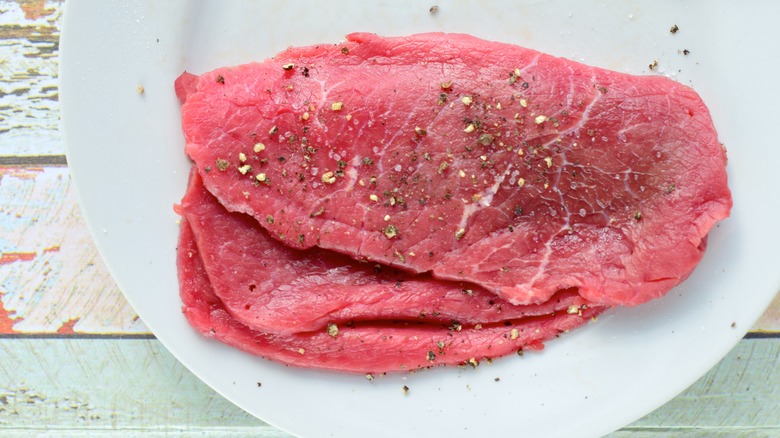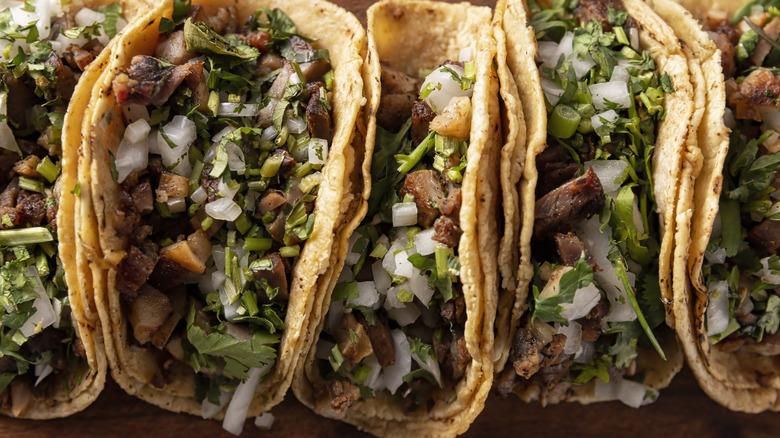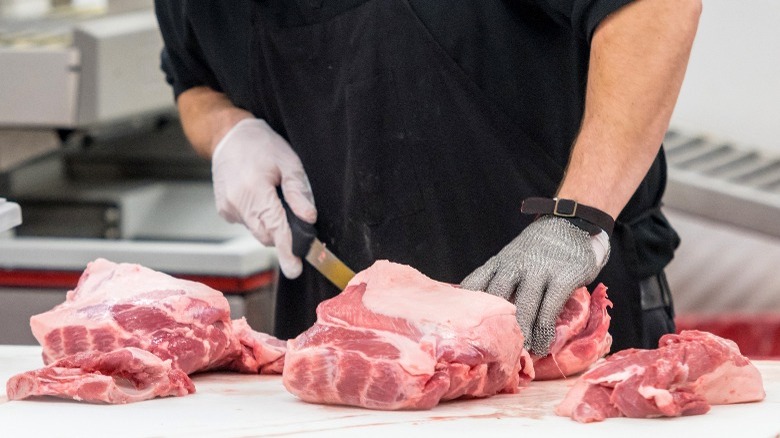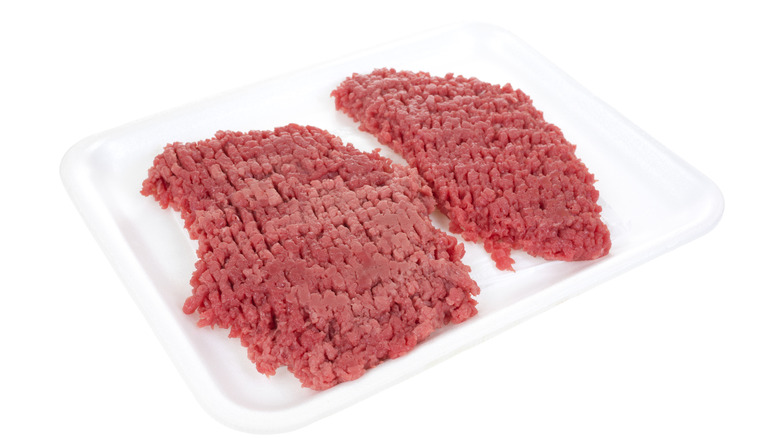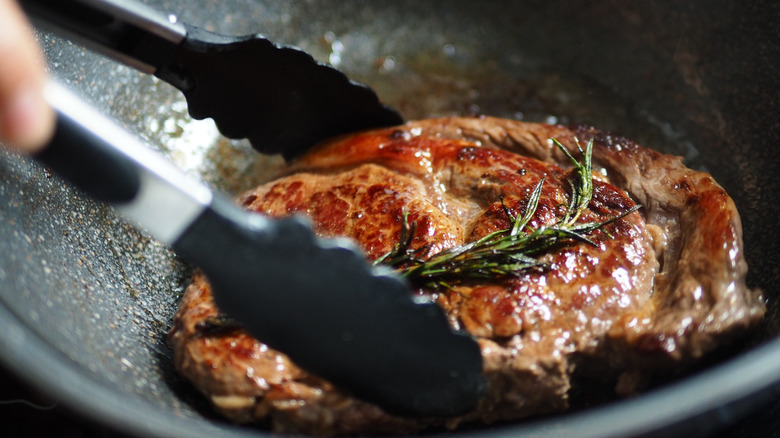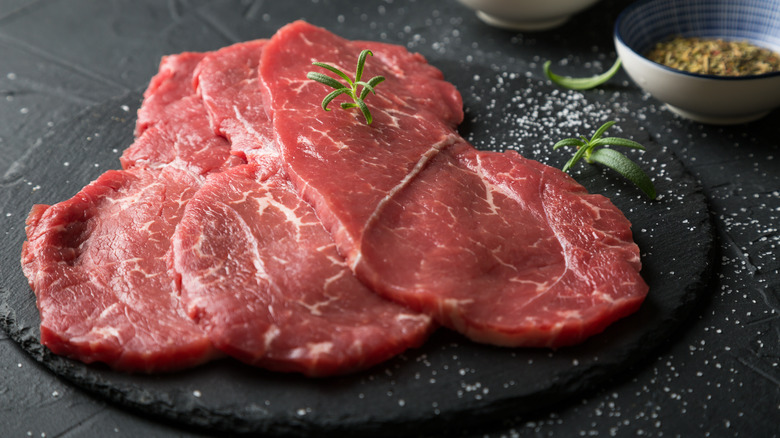What Is Minute Steak And What Kind Of Cut Is It?
When it comes to freshly butchered meat, various cuts and grades can be complex. In the world of beef, we know that cuts like ribeye and filet mignon reign supreme. However, there exists an often-overshadowed cut known as the minute steak.
The idea of this ultra-thin steak — sometimes served dredged in flour, fried, and with gravy — might bring you back to your childhood, or this ingredient might be a mystery to you. Either way, this cut of steak is often misunderstood and overlooked in the kitchen. But we're here to tell you that this is not only an affordable and easy-to-prepare option, but it's also one that will impress your taste buds when prepared correctly. There are a wide variety of recipes out there that can transform this simple ingredient into a well-rounded meal.
Still, there are several tips and tricks that are crucial to working with minute steak. From selecting the right cut to mastering cook times, experimenting with marinades, finessing the art of seasoning, and carefully monitoring temperatures, every detail plays a pivotal role in determining the tenderness and overall quality of your minute steak.
What is minute steak?
Minute steak mainly stands out among other types of beef for its thickness. The cut may come from the rump, sirloin, or other parts of the cow. However, it's the thin slicing that differentiates minute steak. Measuring approximately ¼-inch, this delicate piece of meat is meant to be quickly and swiftly seared to keep it tender and juicy. The name minute steak itself refers to the mere minutes required to cook the steak, which is a game-changer for those looking for convenience in the kitchen.
If you're searching for a melt-in-your-mouth experience, minute steaks that have been cut from the sirloin are your go-to. Known for its tender quality, sirloin minute steaks ensure a juicy dining experience. In comparison, minute steaks taken from the rump offer a slightly leaner quality. These cuts may be packed with flavor, but they may also dry out faster than other cuts, so mind the minute rule when cooking. Either of these cuts will cook just as quickly. Both also would make great minute steaks for Philly cheesesteaks, steak tacos, or a tasty French dip.
How is minute steak made?
But how exactly is this delectable meat made? To answer this question, we must first delve into the world of quality beef production.
Raising cattle is the most important step when looking at how top-notch minute steak is made. Everything from the cow's breed and diet can have an impact on the final product. Top-quality farmers diligently ensure that their cattle graze on nutrient-rich pastures, allowing them to develop robust muscles and impeccable flavors. The journey starts with selecting the best breeds, known for their exceptional marbling and tenderness.
Once the cattle have matured, they are carefully slaughtered and expertly butchered. The process involves separating the animal into various cuts, each with its distinct qualities. As previously discussed, the minute steak may be taken from various cuts, such as the rump or sirloin. Butchers then skillfully trim the meat and slice it thinly. This allows for rapid cooking times, making it a popular choice for those seeking a quick yet satisfying meal.
Finally, minute steaks may be labeled according to the grading system put forth by the United States Department of Agriculture. Grades such as Prime, Choice, Select, and Standard are handed out, indicating the overall quality of the meat, based on factors such as marbling and maturity.
Minute steak vs. cube steak
A common misconception is that cube steak is the same thing as minute steak. But unlike minute steak, cube steak is a cut that undergoes tenderization before being packaged and sold. But minute steak and cube steak are very different cuts and should be treated as such. The key difference lies in the texture and tenderness of each cut.
Minute steak is thin yet smooth. Cube steak, on the other hand, has a bumpy texture. This occurs from the meat being tenderized by a machine that pierces it with numerous small blades or needles. The small cuts can make it look similar to ground beef and can usually be seen very clearly through the packaging. The tenderizing technique breaks up the natural toughness in the tissue of the meat, resulting in a more tender texture.
However, while minute steak can be tender, cube steak is known for being tough. Cube steak is often used in dishes such as chicken-fried steak where cooking methods like frying or braising help further tenderize. Additionally, unlike minute steak, cube steak usually comes from the top or bottom round.
It is important not to confuse cube steak with cubed steak — which is typically used for stews and other slow-cooked dishes. This option consists of pieces of beef cut into cubes, and it does not appear in slices.
How to cook a minute steak
Now that you have your minute steak, it's time to transform the meat into a mouthwatering meal. However, it's all too easy for a cut like this to go from delectable to dry, right before your eyes. These tips will help you achieve that juicy, tender bite of beef you're craving from your minute steak.
There are several cooking options to choose from when preparing minute steak. Although many various methods will get the job done, grilling and searing are our top choices. Searing your steak involves a very hot pan and a watchful eye. Whether you're using a stainless steel pan or a cast iron skillet, be sure to thoroughly heat the pan on high heat. This should take about a minute. Next, add a small amount of fat – olive oil, grapeseed oil, or coconut oil can handle the higher temps. Allow the oil to heat up, then place your steak gently into the pan. The steak should have enough room to lay flat. The minute steak got its name for a reason and should only take about a minute to cook, which means 30 seconds on each side.
Because it's not very thick, just a few seconds on each side will cook the center without drying out the meat. Grilling is a similar idea. Use high heat and only cook the steak for 30 seconds on each side — that's enough to get the job done.
Where to buy minute steak
When it comes to finding the best minute steak, one must be discerning in their choice of butcher or store. Quality is paramount, and the search for high-grade beef is not to be taken lightly. To ensure that your minute steak is of the finest quality, it is essential to seek out sources that offer 100% traceable meat and high-quality grades. This process means that you can trace meat backward from the store shelf to see where it's distributed from, where and how it was processed, and slaughtered. You should be able to determine how the cow was raised as well, whether it was treated with antibiotics, was free range, or was fed an organic diet. Information is power, and that's the case when it comes to choosing the best quality meat.
One option is to visit local butchers, as these establishments often take great pride in their craftsmanship and have a direct connection to the source of their products. By shopping at these smaller, more intimate butcher shops, you can guarantee a level of freshness that may not be found in larger commercial stores.
For those who prefer the convenience of a more familiar shopping experience, there are several well-known stores renowned for their exceptional meat departments. Businesses like Sprouts Farmers Market and Whole Foods Market are good places to consider shopping for minute steak.
Nutritional information about minute steak
Red meat such as minute steak can offer important health benefits, according to Healthline. Red meat contains essential nutrients — such as iron, zinc, and vitamin B12 — that play a crucial role in maintaining your overall well-being. Iron is particularly noteworthy, as it aids in the production of red blood cells, according to the American Red Cross.
However, it is important to enjoy minute steak in moderation. The Dietary Guidelines for Americans suggest that adults should consume no more than 26 ounces of meat, poultry, and eggs per week. By adhering to these guidelines, individuals can ensure they are maintaining a balanced diet that encompasses a variety of protein sources, and not too much of it.
When cooking minute steak, it is advisable to opt for healthier preparation methods such as grilling or pan-searing, with minimal added fats or oils. Pairing a minute steak with a variety of colorful vegetables and whole grains could also further enhance its nutritional value and add important vitamins, minerals, and dietary fiber to the meal.
How to store minute steak
To properly store minute steak, it is crucial to follow the correct procedures. To freeze minute steaks, begin by wrapping each cut with plastic wrap, ensuring a tight seal. Avoid using butcher paper or aluminum foil, as they may not provide adequate protection. The objective is to prevent moisture loss and freezer burn, preserving the steak's fresh quality.
Once the steaks are securely wrapped, place them in a resealable freezer bag. Select a freezer bag that is sturdy and airtight to maintain optimal freshness. Another tip is to clearly label your freezer bags with the date that you placed them in the freezer to make sure the beef is fresh. By adhering to these guidelines, you can extend the shelf life of your minute steak up to three months when frozen correctly. This ensures that you have flavorful and tender cuts readily available whenever you desire.
When storing beef in your fridge for a few days, it is advisable to transfer it to a dish and place plastic wrap or foil securely over the top of it. This allows for proper airflow and prevents excessive sweating of the meat and moisture from gathering. If using a plastic container, ensure that air can circulate around the beef effectively.
